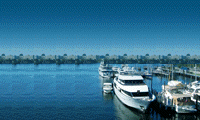

The Marina Harbour Front
Saint Tropez and Portofino are two very famous and popular tourist resorts at the Mediterranean. St. Tropez has had a varied history. It was an unassuming fishing village at the beginning of the 12th Century, a 15th Century military stronghold, and the first town on this coast to be liberated during World War II. After the war, it became an internationally-known seaside resort, renowned principally because of the influx of artists of the French New Wave in cinema and the Ye-ye movement in music. In St. Tropez, there are museums, art galleries, fashion boutiques, cafes, bars, entertainment facilities, seafood and traditional restaurants and etc. around the Port and in the town.
Saint Tropez Portofino is a small fishing village and a tourist resort located in the Province of Genoa on the Italian Riviera. The village, crowded round its small harbour, is considered as one of the most beautiful Mediterranean ports. Portofino was founded by the Romans and was named Portus Delphini or Port of the Dolphin, because of the large numbers of dolphins that inhabited the Tigullian Gulf. The town’s natural harbour supported a fleet of fishing boats which still exist today. However, as wealthy tourists began to arrive in the late 19th Century, more and more vacation houses were built. Since 1950, tourism has supplanted fishing as the town’s chief industry, and its waterfront has become a continuous ring of restaurants and cafes.
Portofino has only around 500 local residents but its daily population could expand to thousands by tourists during the summer months. The magic of Portofino is not due to its architectural master pieces nor careful planning. Rather, it is organic and is responding to the need of the time and to the natural landscape. Portofino Hong Kong also started out as a fishing village, later evolved into a military port of strategic importance and eventually an international financial centre nowadays. As the third largest island in Hong Kong, Lamma was designated by the Imperial Maritime Trade Commission as a stopover place for the foreign merchant ships before proceeding to Guangzhou during the Tang and Song Dynasties.
Showcase of Maritime Tradition and Old Hong Kong
This traditional maritime linkage is interesting because the marina at BoL is purposely designed to receive ocean going yachts coming to Hong Kong or through Hong Kong to other Asian destinations. Unlike cargo ships making regular visits to Hong Kong harbour, many of these ocean going yachts are new to Asian waters, very much like the growing number of foreign ships coming to Hong Kong during the 18th and 19th Century.
Considering that we are proposing to restore the Yung Shue Ha village which was built some 200 years ago as a local cultural heritage, why don’t we also do the same at the marina harbour front? This indeed is an opportunity for us to re-create the old Hong Kong harbour and showcase Hong Kong’s history. Architecturally, the “passive design” features of those early day colonial style buildings were well suit to the climate of Hong Kong at the time and will be adopted as an important element of BoL’s low carbon community.
|






